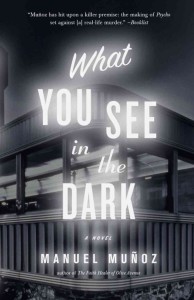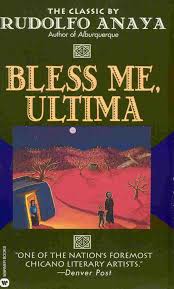In this blog post, I’m basically going to discuss how in most of the books that we read in this semester, except for Their Dogs Came With Them and Gods Go Begging (though it can be argued for them), there is some element or aspect that incorporates a piece of the story or character that is La Llorona. I’m going to look at Antonio’s dreams in Bless Me, Ultima, Concepcion and Tituba in Calligraphy of the Witch, Medea in Hungry Woman, and Arlene Watson in What You See in the Dark. I will incorporate a few summarizing plot points discussed in our class discussions as well as my interpretations of each novel’s similarity with the story of la llorona.
Hungry Woman
The basic plot of Hungry Woman is that a lesbian activist, Medea, is banished from her hometown because of her sexuality, and after some time gone, Medea is confronted by her ex-husband seeking the custody and return of his son, Chac-mool, to which Medea refuses and eventually poisons, kills her son, and then kills herself as well.
I see this novel as a modern interpretation of La Llorona in that it is a lesbian activist in the role of the heterosexual weeping woman. Also, it is interesting to note that Medea cheated on her husband first, not the other way around like most stories tell it. This novel also gives insight into a step-by-step view of the breakdown Medea has, a sort of rationalization that she tells herself as a justification for the murder she is about to commit. This view is typically not show of La Llorona, which is usually commenced with her finding that her husband has been cheating on her and then immediately jumps to the killing, suicide, and haunting. It’s also interesting that this book takes us to a momentary period between Medea’s murdering of her son and her suicide, when she is in a psychiatric facility, which shows that she truly was insane, another trait associated with La Llorona. In almost every obvious way, Medea shares many aspects and elements of La Llorona and could surely be seen as a modern interpretation of the old tale.
What You See in the Dark
This novel follows a rather similar plot to that of the movie, Psycho, which is curiously being filmed at the time that the novel is actually taking place, and in the same town. Basically what happens is that Dan Watson, a well-liked, well-known, handsome man, murders Teresa, a less known, private woman, and the book follows the actions and thoughts of both the residents and the actors of the movie in how they feel about the murder. As the movie Psycho begins filming in the town, there is an eerily similar murder being committed and talked about in the town. The particular aspect of the novel that I found to relate to La Llorona is the character Arlene Watson, Dan’s mother.
I saw an interpretation of La Llorona in Arlene because after she catches her son with bloody clothes, packing a suitcase, rushing out the door, and leaving his bloody truck behind for his mother to dispose, she feels a period of confusion, sadness, shock, and lost. In this scene, she was weeping and asking herself what to do, whether it be to dispose of the vehicle to protect her child or call the police and turn him in. She could not bear the things people were going to say about her and her son once the truth came out and the town knew, and she had a momentary lapse of judgment considering to help her son, but in the end, she did call the police. I saw this as a similar aspect to the story of La Llorona in that, firstly, the father was out of the picture because he had left with another woman, the adulterous act that triggers la llorona. However, the difference between la llorona and Arlene was that La llorona murdered her children, and instead Dan was the one who committed the murder, and thus killing himself in the sense that Arlene did not know who this person was, and did not feel that her boy was alive anymore. Though the comparison is rather weak between the two, I believe that Arlene could be seen as a different kind of weeping woman, though still possessing certain similar aspects to that of La Llorona.
Calligraphy of the Witch
This novel is about a woman, Concepcion, that unexpectedly becomes enslaved and sold to a family in New England as a house slave, where she is seen as impure and evil for speaking Spanish, ends up being pregnant, has her daughter taken to be raised by the owner’s daughter, Rebecca, in Christian tradition, and ends up losing her entirely in the sense that her daughter denies belonging to Concepcion and instead accuses her of witchcraft and attempting to poison her mind with her words (which she then regrets when she reads Concepcion’s letters towards the finale of the novel).
Concepcion shares many aspects with the story of la llorona. Firstly, Concepcion has multiple names throughout her life, something which relates to la llorona which also has multiple names and is said to have multiple places of origin and places of hauntings. Also, la llorona is said to take children from people in attempts to replace them for her children or to be able to see her children again, and through the novel Concepcion fights Rebecca in trying to make Hannah feel that she is her daughter and not Rebecca’s, but utterly fails to do so, by which Hannah stands by Rebecca and her Christianity and declares herself as daughter of Rebecca and has Concepcion labeled as a witch having attempted to corrupt her pure beliefs.
The spiritual nature of the book and surrounding Concepcion and her friend, Tituba, also relate to the gothic elements in la llorona. A being that is alive after death and haunts for children can be seen as closely synonymous with women who speak in “devil’s tongue” and take part in witchcraft, which is what Tituba, Concepcion, and many others are labeled as doing so in the small town on the hill. Another small relation that both stories share is that la llorona ends up killing herself (most stories never say how, but’s it’s safe to assume it could be drowning as well) and in this book, Concepcion, shortly after arriving to New England, makes an attempt to kill herself by jumping in the cold bay water, though is rescued soon after. Although the motives behind dying were different, the action itself parallels similarities.
Bless Me, Ultima
Bless Me Ultima follows the story of a young boy, Antonio, and a curandera, Ultima, along a small town in the Southwest, who come across many different gothic elements: Supernatural, witchcraft, poison, death, sanity, dreams, etc. The story is told as a coming of age of Antonio, through his interaction with Ultima.
In this story, I thought the aspect of la llorona which was set out quite clearly (and already discussed by a few of my classmates) was within Antonio’s dreams. In one of his dreams, Antonio can clearly hear a voice calling to him, while in another he sees shadowy figures calling to him. There are multiple elements of la llorona in these dreams: la llorona is said to call out asking for her children, and as well to children not hers in attempts to lure them and take them away, which is closely related to that which is occurring in Antonio’s dreams. Also, the fact that this is occurring in Antonio’s dreams adds another element of gothic in the sense that there is something dark, mysterious, unknown, and spiritual calling out to Antonio that is clearly not in the physical world, but in a other worldly dream, which can symbolize and parallel the idea that the ghost of the weeping woman, an other worldly entity, walks on the earth in a sort of spiritualistic yet real sense.




